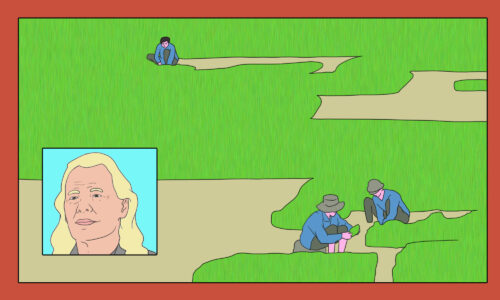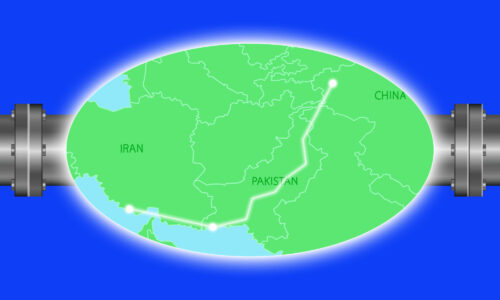The G7’s answer to China’s Belt and Road Initiative
The Partnership for Global Infrastructure and Investment will commit $600 billion to global infrastructure over the next five years. But beyond infrastructural development, the project has just as much of an ideological mission: to counter China’s clout.

The G7 summit was held last week in Bavaria, at Elmau Castle tucked away in the idyllic German Alps, as part of an annual discussion on pressing global issues and to facilitate policy coordination between some of the world’s biggest democratic economies. Short for the “Group of Seven,” (formerly G8, before Russia was indefinitely suspended in 2014 for its annexation of Crimea), participants include Canada, France, Italy, Germany, Japan, the UK, and the U.S.
America’s 46th president took this opportunity to announce the country’s collective commitment to a new global infrastructure program, projected to be $600 billion in scope over the next five years. Called the Partnership for Global Infrastructure and Investment (PGII), this is a rebranding of Joe Biden’s domestic jobs and economic recovery plan, “Build Back Better,” which hasn’t exactly been welcomed with fanfare by Congress or the American public. This is Biden’s chance for a second take.
Africa will be a main beneficiary of PGII, which will be funded by a combination of G7 partners and private capital. Biden explained the new program’s backstory, how they have been working to provide better, more “equitable” options for developing countries (alluding to the popular theory that construction contracts in countries like Zimbabwe or Zambia are allocated in exchange for exploitative mining concessions).
According to a White House briefing, the initiative will encompass investments such as solar mini-grids in Angola, building a submarine telecommunications cable connecting Singapore to France through Egypt and the Horn of Africa, hospital and clinic renovations and construction across Côte d’Ivoire, and technical assistance to the Institut Pasteur de Dakar to construct an industrial-scale vaccine factory in Senegal. But beyond infrastructural development, PGII has just as much of an ideological mission — to counter China’s clout. President Xí Jìnpíng’s 习近平 2013 Belt and Road Initiative (BRI) marked an unprecedented level of foreign commitment to development and construction, particularly across Africa.
“It’s a chance for us to share our positive vision for the future. And let communities around the world see themselves, see for themselves the concrete benefits of partnering with democracies,” Biden said.
China in the Global South
China’s presence was percolating across the Global South well before BRI. For instance, although the earliest Chinese encounter along the Kenyan coast can be traced back to the 15th century, the most modern wave of migration dates to the 1990s. Chinatowns have since then popped up across the capital city of Nairobi, signaling how East Asian migrants — many of whom came to work as part of state-owned enterprises or set up shops and restaurants — have come to call this African nation home.
The early years of the BRI entailed road and railway projects launched across the Eurasian supercontinent and the construction of a maritime pathway across the Indian Ocean. It has since expanded into Arctic agriculture and forays into cyberspace and ICT capacity building in the form of the “Digital Silk Road.” Despite declines in investment during the COVID years, estimates for Chinese investment under the BRI have been as high as $8 trillion back in 2018 (the exact number is hard to come by, given the challenges of calculating costs for “soft power” and “people-to-people” efforts, such as cultural exchanges and education).
As a PGII pioneer, Biden is putting in a laudable effort to counter America’s declining power and influence across Africa. But John Calabrese, the director of American University’s Middle East and Asia Project, says that the U.S. has tricky precedence to overcome. “Africa has never been a top priority in U.S. foreign policy…Each successive U.S. administration, it seems, promises a ‘fresh beginning’ for U.S.-Africa policy and unveils a new initiative, as with Power Africa during the Obama years,” he tells The China Project.
“During Secretary of State Blinken’s trip to the continent last November, he proclaimed: ‘Africa will shape the future — and not just the future of the people of Africa, but of the world.’ But it remains to be seen whether the administration has the bandwidth to follow up with a re-conceptualized, comprehensive approach to the continent as a whole.”
Calabrese does acknowledge important American initiatives, such as the U.S.-African Leaders Summit and U.S. International Development Finance Corporation (DFC). But he worries about lingering myopia behind U.S.-Africa policy, fixating on “an obsession with China.”
A tricky ideological battle
At the G7 summit, Biden described the collective initiative as “a values-driven, high-standard, transparent financing mechanism.” He emphasized the four priority pillars grounding PGII: “We’re going to provide and support projects in four key areas: climate, health, digital technology, and gender equity.”
This type of ideological initiative to counter China’s growing momentum across Africa is not new, according to Efem Ubi, a professor and director of research at the Nigerian Institute of International Affairs. He has a different interpretation of how the West’s involvement has been received on the ground level. “Prior to the influx of China into Africa, it was fashionable to put dictators in power,” Ubi says. “The West forced a lot of developing countries to become democratic by using access to aid as a condition. China will not interfere or intervene with the politics of your country though. Whatever you want, China is prepared to do it for you.”
Justin Siocha, a communications practitioner based in Nairobi who specializes in Chinese economic aid in Africa, agrees that the conditions attached to this new initiative may prove to be a sticking point for recipient African countries. “China just gives you $100 million for roads, but the West likes putting conditions. ‘Be democratic, reduce workforce, show us how you will use it…’ Which is cumbersome for most African states.” Siocha views this new initiative as one primarily rolled out to “contain” China.
A 30-something Kenyan tech startup founder mentions a commonly held belief: “As they say, when a mzungu (white person) visits we get a lecture, when a Chinese visits, we get a road. I think having options is good, but doesn’t necessarily make us smart.”
Where exactly this money will come from remains a question. Siocha has doubts about whether the U.S. has enough money to counter China. “African countries will take money or aid from anyone who gives it to them, so it’s good news especially now with all the economic crises after COVID,” he notes. “The West, especially the U.S., is trying to hold on to their ‘super powers.’ But in my opinion, it’s a good time for African countries to play ball and gain from the competing actors.”
Calabrese explains how the allocation of the PGII initiative will likely work, fleshed out by specific sums of money. “President Biden’s reference to a $200 billion U.S. contribution represents a statement of intent,” the researcher tells The China Project. “The $600 billion is an ‘opening bid,’ which U.S. businesses and others will have to pony up, although there’s no guarantee.” At the G7 summit, Biden announced that the initiative will come from a combination of government funding and private capital from pension, private equity, and insurance funds.
There is concern that such an ambitious initiative is poorly timed as the world retreats into a global recession. Siocha, for one, wonders whether the West currently has the capacity — both in terms of capability and finances — to counter China. But Calabrese notes that the timing makes sense in some ways. “U.S. and European views on China have converged. The Russian invasion of Ukraine has caused the U.S. and Europe to close ranks, and Europe and Asia to be viewed by America’s partners in those regions…as strategically interlinked.”






